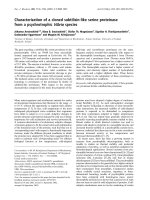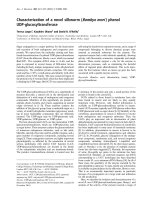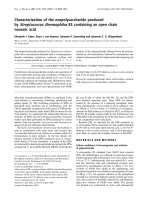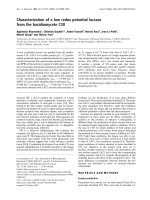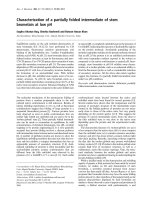Báo cáo Y học: Characterization of selenoprotein P as a selenium supply protein docx
Bạn đang xem bản rút gọn của tài liệu. Xem và tải ngay bản đầy đủ của tài liệu tại đây (210.32 KB, 6 trang )
Characterization of selenoprotein P as a selenium supply protein
Yoshiro Saito* and Kazuhiko Takahashi
Department of Hygienic Chemistry, Graduate School of Pharmaceutical Sciences, Hokkaido University, Sapporo, Japan
Selenium (Se) is well known to be essential for cell culture
when using a serum-free medium, but not when a medium
containing serum is used. This finding suggests that serum
contains some usable form of Se. To identify the Se-supplier,
T-lymphoma (Jurkat) cells were cultured for 3 days in the
presence of human serum immunodepleted of Se-containing
serum protein, selenoprotein P or extracellular glutathione
peroxidase. The Se-dependent enzyme activities (glutathione
peroxidases and thioredoxin reductase) and Se content
within the cells markedly decreased only when cultured with
selenoprotein P-depleted serum. Compared with other
Se-containing proteins, the addition of purified selenopro-
tein P to the selenoprotein P-depleted serum or a serum-free
medium was the most effective for the recovery of cellular
glutathione peroxidase activity (index of Se status). These
results suggest that selenoprotein P functions as a Se-supply
protein, delivering Se to the cells.
Keywords: selenium; selenoprotein; glutathione peroxidase.
Se is an essential micronutrient, and is incorporated into
proteins in the form of selenocysteine (Sec) and selenomethi-
onine. The term selenoprotein is restricted to Sec-containing
proteins [1], and is to be distinguished from proteins that
nonspecifically incorporate selenomethionine. Sec is encoded
by a UGA codon, formerly known only as a stop codon, in
the open reading frame of selenoprotein mRNA that is
accompanied by a Sec insertion sequence element in the
3¢-untranslated region in eukaryotes [2]. More than 15
selenoproteins have been foundin animals, andsome of them
have been shown to exert biological functions [3]. Four types
of glutathione peroxidase (GPx) [4–7], three types of thyroid
hormone deiodinase [8–10], three types of thioredoxin
reductase (TR) [11–13], selenophosphate synthetase [14]
and selenoprotein P (SeP) [15] were identified as enzymes.
Other selenoproteins with as yet unidentified functions, such
as selenoprotein W [16] and a15-kDa selenoprotein [17], have
also been reported. Recently, selenoprotein W was reported
as a glutathione-dependent antioxidant in vivo [18].
Some pathological conditions of Se deficiency, such as
cancer, coronary heart disease and liver necrosis, are
thought to be due to a decrease in selenoprotein levels
[19]. It is also well known that Se is essential for cell culture
when a serum-free medium is used, but not when a medium
containing serum is used [20]. This finding suggests that
serum contains some usable form of Se. Identification of the
Se supplier is critical to understanding the distribution of Se
in the body. There are three serum Se-containing proteins
that are regarded as candidates for the Se-supply protein:
extracellular GPx (eGPx), SeP and albumin. eGPx, a
tetramer containing one Sec per subunit, reduces both
hydrogen peroxide and phospholipid hydroperoxide in the
presence of glutathione (GSH) and thioredoxin [5,21–23].
SeP is a Se-rich extracellular glycoprotein [24–26]. The
sequence of the cDNA predicts that human SeP contains 10
selenocysteines encoded by UGA stop codons in the open
reading frame of its mRNA [27]. Several lines of evidence
in vivo suggest that SeP is a free radical scavenger [28,29].
Recently, we demonstrated that SeP reduces phospholipid
hydroperoxide in the presence of GSH [15]. Albumin may
contain Se in the form of selenomethionine, and does not
contain the element in stoichiometric amounts [30].
In the present study, we describe the first identification of
SeP as a major source of Se for the cells cultured in human
serum. We also demonstrate that SeP is more effective as a
Se supplier than are any other Se-containing proteins and
compounds so far tested. We propose that SeP functions not
only as an antioxidative enzyme but also as a Se supplier.
EXPERIMENTAL PROCEDURES
Chemicals
Diisopropyl fluorophosphate was obtained from Kishida
Chemical Co., Osaka, Japan; tertiary butyl hydroperoxide
and hydrogen peroxide from Nacalai, Kyoto, Japan; GSH,
GSH reductase, RPMI-1640 medium, selenocystine, sele-
nomethionine, DMEM and Hepes from Sigma-Aldrich
Co., St. Louis, MO, USA; recombinant human insulin and
human transferrin from Wako, Osaka, Japan; and nickel-
nitrilotriacetic acid agarose from Qiagen Inc., Chatsworth,
CA, USA. Recombinant human thioredoxin was kindly
Correspondence to K. Takahashi, Department of Hygienic Chemistry,
Graduate School of Pharmaceutical Sciences, Hokkaido University,
Kita 12 Nishi 6, Kita-ku, Sapporo, 060-0812, Japan.
Fax: + 81 11 706 4990, Tel.: + 81 11 706 3244,
E-mail:
Abbreviations: GPx, glutathione peroxidase; cGPx, cellular glutathi-
one peroxidase; eGPx, extracellular glutathione peroxidase; GSH,
glutathione; PH-GPx, phospholipid hydroperoxide glutathione
peroxidase; Sec, selenocysteine; SeP, selenoprotein P;
TR, thioredoxin reductase.
Enzymes: glutathione peroxidase (EC 1.11.1.9); phospholipid hydro-
peroxide glutathione peroxidase (EC 1.11.1.12); glutathione reductase
(EC 1.8.1.7); thioredoxin reductase (EC 1.8.1.9).
*Present address: Human Stress Signal Research Center,
National Institute of Advanced Industrial Science and Technology,
1-8-31 Midorigaoka, Ikeda, Osaka 563–8577, Japan.
(Received 10 June 2002, revised 5 September 2002,
accepted 8 October 2002)
Eur. J. Biochem. 269, 5746–5751 (2002) Ó FEBS 2002 doi:10.1046/j.1432-1033.2002.03298.x
provided by Ajinomoto, Co. Inc., Kawasaki, Japan.
Human serum albumin and human outdated frozen plasma
was kindly donated by the Hokkaido Red Cross Blood
Center. Ebselen was kindly provided by Daiichi Pharma-
ceutical Co., Ltd, Tokyo, Japan. Other chemicals were of
the highest quality commercially available.
Preparation of SeP- and eGPx-depleted human serum
Six monoclonal antibodies (BD1, BD3, BF2, AE2, AH5
and AA3) against human SeP were immobilized as
described previously [31]. After the incubation of anti-
human SeP mAbs-Sepharose 4B with human serum for 1 h
at 4 °C, the obtained supernatant was used as a SeP-
depleted human serum. The depletion of SeP was confirmed
by a sandwich enzyme-linked immunosorbent assay for
human SeP, as described previously [31]. SeP was undetect-
able (< 2%) after this treatment. eGPx-depleted human
serum was prepared using anti-human eGPx polyclonal Ig–
conjugated Sepharose 4B. The depletion of eGPx was
confirmed by coupled enzymatic assay with GSH reductase,
as described previously [5]. The enzyme activity of eGPx was
undetectable (< 2%) after this treatment. Anti-human TR
mAb (KB12)–conjugated Sepharose 4B was used for the
control experiment [32].
Se assay
Levels of Se in each serum and in the cell were determined
according to the fluorometric method of Bayfield and
Romalis [33].
Cell culture and cytosol preparation
Jurkat E6-1 cells, human T-leukemia (American Tissue
Type Collection, Rockville, MD, USA), were maintained in
RPMI-1640 medium containing 10% (v/v) fetal bovine
serum at 37 °C under an atmosphere of 95% (v/v) air and
5% (v/v) CO
2
. For studies on the effects of selenoprotein-
depletion from human serum, the cells were cultured with
RPMI-1640 medium containing 5% (v/v) of each human
serum. Serum-free medium (RPMI-1640 containing
5 lgÆmL
)1
human insulin, 5 lgÆmL
)1
human transferrin,
5mgÆmL
)1
human serum albumin and 2 l
M
a-tocopherol)
was also used. After culturing for the specified periods, the
cells were collected by centrifugation and resuspended in an
appropriate volume of 50 m
M
Tris/HCl, pH 7.4, containing
0.25
M
sucrose, 0.1 m
M
EDTA, 0.7 m
M
2-mercaptoethanol
and 2 m
M
diisopropyl fluorophosphate. The cell suspension
was sonicated with an Ultra Sonic homogenizer VP-5s
(Taitec, Tokyo, Japan), and centrifuged at 105 000 g for 1 h
at 4 °C to obtain a cytosolic fraction.
GPx enzyme assay
GPx activities were examined by following the oxidation of
NADPH in the presence of GSH reductase, which catalyzes
the reduction of the oxidized GSH formed by GPx [5]. To
measure cellular GPx (cGPx) activities, both the sample
and reference cuvettes contained 0.1
M
Tris/HCl, pH 8.0,
0.2 m
M
NADPH, 0.5 m
M
EDTA, 2 m
M
GSH and 1 U of
GSH reductase in a total volume of 1 mL. An aliquot of
the cytosolic fraction was added to the sample cuvette only.
The reaction mixture was preincubated at 37 °Cfor2min,
after which the reaction was started by the addition of
70 nmol tertiary-butyl hydroperoxide to both cuvettes. To
measure phospholipid hydroperoxide GPx (PH-GPx)
activity, the reaction mixture contained 0.1
M
Tris/HCl,
pH 8.0, 0.2 m
M
NADPH, 0.5 m
M
EDTA, 1 m
M
NaN
3
,
5m
M
GSH and 1 U of GSH reductase and 60 nmol
1-palmitoyl-2-(13-hydroperoxy-cis-9,trans-11-octadecadienoyl)-
3-PtdCho hydroperoxide was added [15]. The oxidation of
NADPH was followed at 340 nm at 37 °C and activity
was expressed as micromoles of NADPH oxidized per
minute.
TR enzyme assay
TR activity was examined by spectrophotometric insulin
reduction assay, as described previously with a slight
modification [34]. Both sample and reference cuvettes
contained 50 m
M
phophate buffer, pH 7.0, 1 m
M
EDTA,
0.2 m
M
NADPH, and 0.8 l
M
human recombinant thiore-
doxin in a total volume of 1 mL. An aliquot of the cytosolic
fraction was added to the sample cuvette only. The reaction
mixture was preincubated at 37 °C for 2 min, after which
the reaction was started by the addition of 80 nmol insulin
to both cuvettes. The oxidation of NADPH was followed at
340 nm at 37 °C and activity was expressed as micromoles
of NADPH oxidized per minute.
GSH reductase enzyme assay
GSH reductase activities were examined by following the
NADPH oxidation in the presence of oxidized glutathione
[35]. The assay mixture contained 50 m
M
phosphate buffer,
pH 7.6, 1 m
M
EDTA, 0.1 m
M
NADPH, and 1 m
M
oxidized glutathione. Activity was calculated as micromoles
of NADPH oxidized per minute.
Purification of SeP and eGPx
SeP and eGPx were purified from human plasma using
conventional chromatographic methods as described previ-
ously [5,15].
RESULTS
Immunodepletion of SeP and eGPx from human serum
To identify a Se supply protein for the cells cultured in
human serum, we first prepared SeP- and eGPx-depleted
human serum with immobilized antibodies. The addition of
immobilized anti-human SeP and anti-eGPx Igs reduced the
Se content to 47 and 81%, respectively (Fig. 1). This
suggests that 53 and 19% of serum Se content is derived
from SeP and eGPx, respectively. No decrease was observed
after treatment with the immobilized control antibody. The
residual 28% of Se may be derived mainly from albumin in
the form of selenomethionine [30].
Se deficiency in cells cultured with SeP-depleted
human serum
We then investigated the effect of selenoprotein depletion
from serum on the Se-dependent enzymatic activities and Se
Ó FEBS 2002 Selenoprotein P as a selenium supply protein (Eur. J. Biochem. 269) 5747
content of cultured Jurkat cells (Fig. 2). When cultured
solely in the presence of SeP-depleted serum and not eGPx-
depleted or the control serum, the activity of cellular GPx
(cGPx), a major Se-dependent enzyme, decreased to 17%
that of the control (Fig. 2A). The activity of two other
Se-dependent enzymes, phospholipid hydroperoxide GPx
(PH-GPx)andTR,alsodecreasedto16and38%,
respectively. However, almost no change in the activities
of other antioxidant enzymes, such as superoxide dismutase
and glutathione reductase, was observed (data not shown).
When cultured with SeP-depleted serum, the Se content of
the whole cell and the cytosol also decreased to 19 and 35%
that of control cells, respectively (Fig. 2B).
Next,westudiedthetimecourseofthecGPxactivity(as
an indication of Se status) of cells cultured with SeP-
depleted serum (Fig. 3). cGPx activity was almost unde-
tectable after 4 days. The addition of 270 ngÆmL
)1
purified
SeP, which corresponded to the SeP concentration of 5%
serum, resulted in the complete recovery of cGPx activity
within 2 days.
Effect of addition of SeP on the cGPx activity
of Jurkat cells
To compare SeP with other Se-containing proteins or
compounds as a Se supplier, we studied the effect of seven
reagents on the cGPx activity of the cells (Fig. 4A). SeP was
the most effective with a 50% effective dose (ED
50
)of5n
M
(Se equivalent), followed by eGPx, sodium selenite, seleno-
cystine, selenomethionine and albumin. The ED
50
of the
former three reagents was 25 n
M
, and that of the latter two
were 300 and 500 n
M
, respectively. Ebselen had no effect up
to 500 n
M
. To eliminate the effect of serum proteins on the
activity of SeP as a Se supplier, a similar experiment was
conducted using a serum-free medium. Essentially identical
results were obtained using the serum-free medium
(Fig. 4B), and SeP was again the most effective.
DISCUSSION
SeP is an extracellular protein that has been postulated to
have an oxidant defense function [28,29]. We recently
reported that SeP reduces phospholipid hydroperoxide in
the presence of GSH [15]. SeP is also reported to have
Fig. 2. Effect of selenoprotein depletion on the selenoenzyme activities
and Se content in Jurkat cells. The cells were cultured for 3 days in
RPMI-1640 medium containing 5% (v/v) of each human serum.
cGPx, PH-GPx, TR activity and Se content were determined, as des-
cribed in Experimental procedures.
Fig. 3. Effect of SeP on the cGPx activity of Jurkat cells. The cells were
cultured in RPMI-1640 medium containing 5% (v/v) of SeP-depleted
human serum, and cGPx activity was measured. After 6 days, purified
SeP, corresponding to the SeP concentration of 5% serum, was added.
Fig. 1. Se concentration in selenoprotein-depleted human serum and the
estimation of Se components in human serum. Preparation of each
human serum and measurement of Se concentration were conducted as
described in Experimental procedures. (A) Se concentrations in
selenoprotein-depleted human serum and in the control are shown.
These values are the means of six experiments with the error bar in-
dicating SD. (B) Se concentrations and percentages in each component
were calculated from the data shown in (A).
5748 Y. Saito and K. Takahashi (Eur. J. Biochem. 269) Ó FEBS 2002
survival-promoting properties for cultured neurons [36].
Because of its high Se content and extracellular localization,
SeP has also been suggested to be a Se supply protein.
It is known that serum-free culture media for immune cells
and neurons contain insulin (as a growth factor), transferrin
(as an iron source) and sodium selenite (as a Se source).
Without these compounds, the cells can neither survive nor
proliferate. This suggests that some usable form of Se in
serum can provide Se to the cells instead of sodium selenite.
Using an in vitro cell culture system, we investigated which
Se-containing proteins or compounds supplies Se to the cells.
Several methods have been employed to determine the
proportion of total Se in human serum (or plasma)
accounted for by SeP. Using heparin–agarose, SeP accoun-
ted for 40% of the Se applied to the column [37]. The SeP in
the plasma of Chinese men of varying Se status accounted
for 50–60% of the total Se in their plasma [38]. In another
approach based on immunoassay, 40–44% of the total Se
was reported to be in the form of SeP in healthy US subjects
[39]. In our study, we first prepared SeP- and eGPx-depleted
human serum. Se analysis shows that SeP and eGPx
contains 53% and 19% of the total serum Se content of
healthy Japanese human subjects, respectively (Fig. 1B).
The proportion of total Se in human serum accounted for
by SeP varied between regions and can be expected to reflect
differences in Se intake. Thus, our results essentially
confirmed the previous findings described above.
Jurkat cells that had been cultured in the presence of SeP-
depleted serum became Se-deficient in a time-dependent
manner. Under these culture conditions, the cells duplicate
at 18 h intervals. We speculate that the divided cells contain
one half of the Se content, and that the cells became
Se-deficient 4 days later. When human peripheral lympho-
cytes were incubated with SeP-depleted serum, the cells did
not become Se-deficient (Y. Saito and K. Takahashi,
unpublished observation). As peripheral lymphocytes do
not proliferate, perhaps only proliferating cells (such as
hemopoietic cells, spermatocytes and neurons) become Se-
deficient when cultured with SeP-depleted serum. The fact
that new neurons are continually added to the neocortex of
adult macaque monkeys has profound implications for the
understanding of the cellular mechanisms of higher cogni-
tive functions [40]. However, the addition of purified SeP to
Se-deficient cells resulted in the recovery of cellular GPx
activity within 2 or 3 days.
Next, we compared the Se-supply activity of SeP with two
other Se-containing serum proteins, eGPx and albumin.
The 50% effective dose (ED
50
) of SeP, eGPx and albumin
was 5, 25 and 500 n
M
(Se equivalent), respectively. The Se
concentration of SeP, eGPx and albumin in 5% human
serum was 42, 15 and 22 n
M
(Se equivalent), respectively.
This suggests that SeP mainly supplies Se to cells under
physiological conditions.
Essentially identical results were obtained in a serum-free
medium in the presence of 2 l
M
a–tocopherol. In a serum-
free medium without a-tocopherol, the cells could not
survive in a Se-deficient state. This suggests that a–toco-
pherol protects Se-deficient cells from cell death by oxidative
stress. Actually 5% serum contains 0.9 l
M
a-tocopherol.
Thus, the cells could survive even in a Se-deficient state in
the presence of SeP-depleted serum. This speculation is
supported by reports that SeP is a suvival-promoting factor
for cultured central neurons [36]. In the study in which SeP
was identified as a survival-promoting factor, the culture
medium contained transferrin, insulin, albumin but not
sodium selenite.
Our observations indicate that SeP functions as a Se
supplier for the proliferating cells. Little is known about the
function of a group of serum proteins concerned in the
supply of substances of small molecular weight. The most
studied of these is transferrin, which is concerned in the
distribution of iron from the intestinal absorption sites to
the various tissues requiring iron [41]. Albumin is believed to
supply many low-molecular-mass substances such as metals,
amino acids and fatty acids [42]. Transferrin and albumin
noncovalently bind iron and many low-molecular-mass
substances, respectively. As Se is covalently bound in SeP,
the supply mechanism is presumed to require digestion of
SeP by proteases and peptidases, and the breakdown of
selenocysteine for release of its Se, and must be proved in the
future.
A serum-free medium containing Se (sodium selenite) was
used to culture a variety of cells, neurons and hemopoietic
(especially immune) cells. Without Se, the cells could neither
survive nor proliferate. SeP is taken up in greater amounts
Fig. 4. Effect of the addition of Se-containing compounds on the cGPx
activity of Jurkat cells in serum or serum-free medium. In the presence of
variable amounts of Se-containing compounds, the cells were cultured
with SeP-depleted serum (A) or serum-free medium (B), as described in
Experimental procedures. After 3 days, the cells were collected and
cGPx activity was measured. Open circles, SeP (185 nmol SeÆmg
)1
of
protein); closed circles, eGPx; (53 nmol SeÆmg
)1
of protein); open
squares, sodium selenite; closed squares, selenocystine; open triangles,
selenomethionine; closed triangles, human serum albumin (8.3 pmol
SeÆmg
)1
of protein); open circles with broken line, ebselen.
Ó FEBS 2002 Selenoprotein P as a selenium supply protein (Eur. J. Biochem. 269) 5749
by the brain but not by other organs in Se-deficient animals
[43], suggesting a critical function of this selenoprotein in
this organ. It has survival-promoting properties for cultured
neurons [36] and its mRNA is present in the brain [44].
Furthermore, it is reported that astrocytes and cerebellar
granule cells secrete SeP [45]. A recent finding that new
neurons are continually added to the neocortex suggests
that SeP secreted from astrocytes and cerebellar granule
cells may supply Se to proliferating neurons. Numerous
studies suggest that a deficiency of Se is accompanied by a
loss of immunocompetence, probably not unconnected with
the fact that Se is normally found in significant amounts in
immune tissues such as the spleen, and lymph nodes. Both
cell-mediated immunity and B-cell function can be impaired
[46]. Supplementation with Se has marked immunostimu-
lant effects, including an enhancement of proliferation of
activated T cells [47].
In the present study, we identify SeP as a Se supply
protein to proliferating T lymphoma cells. The essential
roles of Se in brain and immune functions described above
and our in vitro studies strongly suggest that SeP supplies Se
to the proliferating brain and hemopoietic cells. Thus, we
propose that SeP functions not only as an antioxidative
enzyme but also functions as a Se supplier.
ACKNOWLEDGEMENTS
This work was supported in a party by a Grant-in-Aid for Scientific
Research from the Ministry of Education, Culture, Sports, Science and
Technology of Japan. We thank Hokkaido Red Cross Blood Center for
providing human plasma. Y. Saito is the recipient of a research
fellowship from the Japan Society for the Promotion of Science for
Young Scientists.
REFERENCES
1. Stadtman, T.C. (1996) Selenocysteine. Annu. Rev. Biochem. 65,
83–100.
2. Hatfield, D.L. & Gladyshev, V.N. (2002) How selenium has
altered our understanding of the genetic code. Mol. Cell. Biol. 22,
3565–3576.
3. Behne, D. & Kyriakopoulos, A. (2001) Mammalian selenium-
containing proteins. Annu. Rev. Nutr. 21, 453–473.
4. Flohe, L., Gunzler, W.A. & Schock, H.H. (1973) Glutathione
peroxidase: aselenoenzyme. FEBS Lett. 32, 132–134.
5. Takahashi, K., Avissar, N., Whitin, J. & Cohen, H. (1987) Puri-
fication and characterization of human plasma glutathione per-
oxidase: a selenoglycoprotein distinct from the known cellular
enzyme. Arch. Biochem. Biophys. 256, 677–686.
6. Ursini,F.,Maiorino,M.&Gregolin,C.(1985)Theselenoenzyme
phospholipid hydroperoxide glutathione peroxidase. Biochim.
Biophys. Acta 839, 62–70.
7. Chu, F.F., Doroshow, J.H. & Esworthy, R.S. (1993) Expression,
characterization, and tissue distribution of a new cellular selenium-
dependent glutathione peroxidase, GSHPx-GI. J. Biol. Chem. 268,
2571–2576.
8. Behne, D., Kyriakopoulos, A., Meinhold, H. & Kohrle, J. (1990)
Identification of type I iodothyronine 5¢-deiodinase as a seleno-
enzyme. Biochem. Biophys. Res. Commun. 173, 1143–1149.
9. Croteau, W., Davey, J.C., Galton, V.A. & St Germain, D.L. (1996)
Cloning of the mammalian type II iodothyronine deiodinase. A
selenoprotein differentially expressed and regulated in human and
rat brain and other tissues. J. Clin. Invest 1998, 405–417.
10. Croteau, W., Whittemore, S.L., Schneider, M.J. & St Germain,
D.L. (1995) Cloning and expression of a cDNA for a mammalian
type III iodothyroninedeiodinase. J. Biol. Chem. 270, 16569–
1657511.
11. Tamura, T. & Stadtman, T.C. (1996) A new selenoprotein from
human lung adenocarcinoma cells: purification, properties, and
thioredoxin reductase activity. Proc. Natl Acad. Sci. USA 93,
1006–1011.
12. Gasdaska, P.Y., Berggren, M.M., Berry, M.J. & Powis, G. (1999)
Cloning, sequencing and functional expression of a novel human
thioredoxin reductase. FEBS Lett. 442, 105–111.
13. Sun, Q.A., Wu, Y., Zappacosta, F., Jeang, K.T., Lee, B.J.,
Hatfield, D.L. & Gladyshev, V.N. (1999) Redox regulation of cell
signaling by selenocysteine in mammalian thioredoxin reductases.
J. Biol. Chem. 274, 24522–24530.
14. Guimaraes, M.J., Peterson, D., Vicari, A., Cocks, B.G., Copeland,
N.G., Gilbert, D.J., Jenkins, N.A., Ferrick, D.A., Kastelein, R.A.,
Bazan, J.F. & Zlotnik, A. (1996) Identification of a novel selD
homolog from eukaryotes, bacteria, and archaea: is there an
autoregulatory mechanism in selenocysteine metabolism? Proc.
Natl Acad. Sci. USA 93, 15086–15091.
15. Saito, Y., Hayashi, T., Tanaka, A., Watanabe, Y., Suzuki, M.,
Saito, E. & Takahashi, K. (1999) Selenoprotein P in human
plasma as an extracellular phospholipid hydroperoxide glu-
tathione peroxidase. Isolation and enzymatic characterization of
human selenoprotein P. J. Biol. Chem. 274, 2866–2871.
16. Vendeland, S.C., Beilstein, M.A., Chen, C.L., Jensen, O.N.,
Barofsky, E. & Whanger, P.D. (1993) Purification and properties
of selenoprotein W from rat muscle. J. Biol. Chem. 268, 17103–
17107.
17. Gladyshev, V.N., Jeang, K.T., Wootton, J.C. & Hatfield, D.L.
(1998) A new human selenium-containing protein. Purification,
characterization, and cDNA sequence. J. Biol. Chem. 273, 8910–
8915.
18. Jeong, D., Kim, T.S., Chung, Y.W., Lee, B.J. & Kim, I.Y. (2002)
SelenoproteinW is a glutathione-dependent antioxidant in vivo.
FEBS Lett. 517, 225–228.
19. Allan, C.B., Lacourciere, G.M. & Stadtman, T.C. (1999)
Responsiveness of selenoproteins to dietary selenium. Annu. Rev.
Nutr. 19, 1–16.
20. McKeehan, W.L., Hamilton, W.G. & Ham, R.G. (1976) Selenium
is an essential trace nutrient for growth of WI-38 diploid human
fibroblasts. Proc. Natl Acad. Sci. U.S.A. 73, 2023–2027.
21. Takahashi, K., Akasaka, M., Yamamoto, Y., Kobayashi, C.,
Mizoguchi, J. & Koyama, J. (1990) Primary structure of human
plasma glutathione peroxidase deduced from cDNA sequences.
J. Biochem. 108, 145–148.
22. Yamamoto, Y. & Takahashi, K. (1993) Glutathione peroxidase
isolated from plasma reduces phospholipid hydroperoxides. Arch.
Biochem. Biophys. 305, 541–545.
23. Takebe, G., Yarimizu, J., Saito, Y., Hayashi, T., Nakamura,
H., Yodoi, J., Nagasawa, S. & Takahashi, K. (2002) A com-
parative study on the hydroperoxide and thiol specificity of the
glutathione peroxidase family and selenoprotein P. J. Biol. Chem.
277, 41254–41258.
24. Burk, R.F. & Hill, K.E. (1994) Selenoprotein P. A selenium-rich
extracellular glycoprotein. J. Nutr. 124, 1891–1897.
25. Mostert, V. (2000) Selenoprotein P: properties, functions, and
regulation. Arch. Biochem. Biophys. 376, 433–438.
26. Saito, Y. & Takahashi, K. (2000) Selenoprotein P: Its structure
and functions. J. Health Sci. 46, 409–413.
27. Hill, K.E., Lloyd, R.S., Yang, J.G., Read, R. & Burk, R.F. (1991)
The cDNA forrat selenoprotein P contains 10 TGA codons in the
open reading frame. J. Biol. Chem. 266, 10050–10053.
28. Burk, R.F., Hill, K.E., Awad, J.A., Morrow, J.D., Kato, T.,
Cockell, K.A. & Lyons, P.R. (1995) Pathogenesis of diquat-
induced liver necrosis inselenium-deficient rats: assessment of the
roles of lipid peroxidation and selenoprotein P. Hepatology 21,
561–569.
5750 Y. Saito and K. Takahashi (Eur. J. Biochem. 269) Ó FEBS 2002
29. Burk, R.F., Hill, K.E., Awad, J.A., Morrow, J.D. & Lyons, P.R.
(1995) Liver and kidney necrosis in selenium-deficient rats de-
pleted of glutathione. Laboratory Invest. 72, 723–730.
30. Deagen, J.T., Beilstein, M.A. & Whanger, P.D. (1991) Chemical
forms of selenium in selenium containing proteins from human
plasma. J. Inorg. Biochem. 41, 261–268.
31. Saito, Y., Watanabe, Y., Saito, E., Honjoh, T. & Takahashi, K.
(2001) Production and application of monoclonal antibodies to
human selenoprotein P. J. Health Sci. 2247, 346–352.
32. Yarimizu, J., Nakamura, H., Yodoi, J. & Takahashi, K. (2000)
Efficiency of selenocysteine incorporation in human thioredoxin
reductase. Antioxid. Redoxsignal. 2, 643–651.
33. Bayfield, R.F. & Romalis, L.F. (1985) pH Control in the fluoro-
metric assay for selenium with 2,3- diaminonaphthalene. Anal.
Biochem. 144, 569–576.
34. Holmgren, A. & Bjornstedt, M. (1995) Thioredoxin and thior-
edoxin reductase. Methods Enzymol. 252, 199–208.
35. Luthman, M. & Holmgren, A. (1982) Rat liver thioredoxin and
thioredoxin reductase: purification and characterization. Bio-
chemistry 21, 6628–6633.
36. Yan, J. & Barrett, J.N. (1998) Purification from bovine serum of
a.23survival-promoting factor for cultured central neurons and its
identification as selenoprotein-P. J. Neurosci. 18, 8682–8691.
37. Akesson,B.&Martensson,B.(1991)Chromatographyofsele-
noproteins in human serum using matrix-bound heparin. Int. J.
Vitam. Nutr. Res. 61, 72–76.
38. Deagen, J.T., Butler, J.A., Zachara, B.A. & Whanger, P.D. (1993)
Determinationof the distribution of selenium between glutathione
peroxidase, selenoprotein P, and albumin in plasma. Anal. Bio-
chem. 208, 176–181.
39. Hill, K.E., Xia, Y., Akesson, B., Boeglin, M.E. & Burk, R.F.
(1996) Selenoprotein P concentration in plasma is an index of
selenium status inselenium-deficient and selenium-supplemented
Chinese subjects. J. Nutr. 126, 138–145.
40. Gould, E., Reeves, A.J., Graziano, M.S. & Gross, C.G. (1999)
Neurogenesis in the neocortex of adult primates. Science 286, 548–
552.
41. Qian, Z.M. & Tang, P.L. (1995) Mechanisms of iron uptake by
mammalian cells. Biochim. Biophys. Acta 1269, 205–214.
42. Curry, S., Brick, P. & Franks, N.P. (1999) Fatty acid binding to
human serum albumin: new insights from crystallographic studies.
Biochim. Biophys. Acta 1441, 131–140.
43. Burk, R.F., Hill, K.E., Read, R. & Bellew, T. (1991) Response of
ratselenoprotein P to selenium administration and fate of its
selenium. Am. J. Physiol. 261, E26–E30.
44. Saijoh, K., Saito, N., Lee, M.J., Fujii, M., Kobayashi, T. &
Sumino, K. (1995) 24Molecular cloning of cDNA encoding a
bovine selenoprotein P-like protein containing 12 selenocysteines
and a (His-Pro) rich domain insertion, and its regional expression.
Mol. Brain Res. 30, 301–311.
45. Yang, X., Hill, K.E., Maguire, M.J. & Burk, R.F. (2000) Synthesis
and secretion of selenoprotein P by cultured rat astrocytes. Bio-
chim. Biophys. Acta 1474, 390–396.
46. McKenzie, R.C., Rafferty, T.S. & Beckett, G.J. (1998) Selenium:
an essential element for immune function. Immunol. Today 19,
342–345.
47. Kiremidjian-Schumacher,L.,Roy,M.,Wishe,H.I.,Cohen,M.W.
& Stotzky, G. (1994) Supplementation with selenium and human
immune cell functions. II. Effect on cytotoxic lymphocytes and
natural killer cells. Biol. Trace Elem. Res. 41, 115–127.
Ó FEBS 2002 Selenoprotein P as a selenium supply protein (Eur. J. Biochem. 269) 5751

